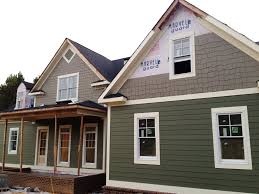 Once humans began constructing four-sided shelters, they began to write the first chapters in the history of siding. The earliest types of wall cladding used materials that could be found locally and were easy to apply; twigs, animal hides, stone, mud and wood were just some of the choices selected for prehistoric structures. In later centuries, bricks, stone, wood, stucco and plaster were frequently used. By the dawn of the 20th century, siding options had become more numerous.
Once humans began constructing four-sided shelters, they began to write the first chapters in the history of siding. The earliest types of wall cladding used materials that could be found locally and were easy to apply; twigs, animal hides, stone, mud and wood were just some of the choices selected for prehistoric structures. In later centuries, bricks, stone, wood, stucco and plaster were frequently used. By the dawn of the 20th century, siding options had become more numerous.
Siding Installation: An Interesting History
Asbestos Shingle Siding
Asbestos shingle siding first appeared in 1907. The product is a mixture of cement, water and asbestos that is compressed to create sheets measuring approximately 6 square feet. Due to its superior resistance to fire, the National Board of Fire Underwriters heartily endorsed asbestos siding during the 1920s.
Asbestos siding is remarkably durable, but its lack of flexibility meant that it can be cracked by moderate impacts. Many homes show signs of damage on the bottom row from being impacted by lawn mowers, children’s wheeled toys or other objects. Despite its somewhat brittle nature, however, asbestos shingle siding was an extremely popular choice for more than 70 years. The ban issued by the Environmental Protection Agency in 1973 prohibiting asbestos in the manufacture of building materials as well as the public awareness of the link between asbestos and mesothelioma led to a rapid decline in the use of asbestos siding.
Aluminum Siding
Aluminum siding was first marketed during the late 1940s, achieving its greatest popularity between 1950 and 1990. Homeowners were swayed by promises that they would never need to paint their siding again. However, there is little adhesion between the siding and the paint; the two surfaces respond differently to changes in temperature, leading to frequent, large-scale shedding of the paint. The paint was also prone to fading.
In addition to the issues with the paint, other problems contributed to the decline in popularity of aluminum siding. For example, it dents easily; minor impacts, including hail, car doors or baseballs, left noticeable dents. The siding’s ability to conduct heat left dark-colored siding extremely warm to the touch during the summer months. In winter, the siding can draw heat from the interior, requiring additional insulation. Aluminum siding retains approximately 15 percent of the market share, primarily in the Midwest and Northeast.
Vinyl Siding
During the 1950s, there was a trend to embrace new materials and products, so when vinyl siding was introduced, it became a hit virtually overnight. Like aluminum siding, vinyl siding was marketed as never needing paint. Unfortunately, vinyl siding fades or yellows when exposed to the sun, and repainting is a complicated process that is normally expensive and often ineffective. Vinyl can also buckle or warp from heat, traps moisture behind it, is extremely easy to damage and emits toxic fumes in the event of a fire. Nevertheless, vinyl siding remains popular, especially for mobile homes, renovations and starter homes.
Fiber Cement Siding
Fiber cement siding was introduced in the United States during the 1990s. By 2014, the product had claimed approximately 69 percent of the market. Much of the popularity of fiber cement siding involves its superior resistance to fire, rot and insects. Since fiber cement siding is available in a variety of styles, colors and textures, it is easy to create a unique exterior. However, although vinyl and aluminum siding can sometimes be installed by a skilled homeowner, fiber cement siding requires a well-trained, experienced installer possessing the proper tools. Otherwise, the siding can be damaged during the installation; improper installation can also lead to problems with water penetration or other issues.
Where to Learn More
Alpha Roofing is a highly respected roofing company with well-trained, experienced crews. We install fiber cement and wood siding, skylights, metal roofing systems and asphalt shingles. We also repair chimneys, roofs and flashing. We deliver professional work that is of superior quality, but our prices are competitive. If you have more questions about Siding Installation: An Interesting History, or request a free quote, you can contact us by using the online form or calling (512) 777-1086.
